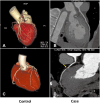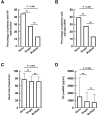Coronary artery stenosis associated with right ventricular dysfunction in acute pulmonary embolism: A case-control study
- PMID: 40693565
- PMCID: PMC12369834
- DOI: 10.1097/CM9.0000000000003729
Coronary artery stenosis associated with right ventricular dysfunction in acute pulmonary embolism: A case-control study
Abstract
Background: The potential impact of pre-existing coronary artery stenosis (CAS) on right ventricular (RV) function during acute pulmonary embolism (PE) episodes remains underexplored. This study aimed to investigate the association between pre-existing CAS and RV dysfunction in patients with acute PE.
Methods: In this multicenter, case-control study, 89 cases and 176 controls matched for age were enrolled at three study centers (Peking Union Medical College Hospital, Fuwai Hospital, and the Second Affiliated Hospital of Harbin Medical University) from January 2016 to December 2020. The cases were patients with acute PE with CAS, and the controls were patients with acute PE without CAS. Coronary artery assessment was performed using coronary computed tomographic angiography. CAS was defined as ≥50% stenosis of the lumen diameter in any coronary vessel >2.0 mm in diameter. Conditional logistic regression analysis was used to evaluate the association between CAS and RV dysfunction.
Results: The percentages of RV dysfunction (19.1% [17/89] vs. 44.6% [78/176], P <0.001) and elevated systolic pulmonary artery pressure (sPAP) (19.3% [17/89] vs. 39.5% [68/176], P = 0.001) were significantly lower in the case group than those in the control group. In the multivariable logistic regression model, CAS was independently and negatively associated with RV dysfunction (adjusted odds ratio [OR]: 0.367; 95% confidence interval [CI]: 0.185-0.728; P = 0.004), and elevated sPAP (OR: 0.490; 95% CI: 0.252-0.980; P = 0.035), respectively.
Conclusions: Pre-existing CAS was significantly and negatively associated with RV dysfunction and elevated sPAP in patients with acute PE. This finding provides new insights into RV dysfunction in patients with acute PE with pre-existing CAS.
Keywords: Coronary artery stenosis; Pulmonary embolism; Right ventricular dysfunction; Systolic pulmonary artery pressure.
Copyright © 2025 The Chinese Medical Association, produced by Wolters Kluwer, Inc. under the CC-BY-NC-ND license.
Conflict of interest statement
None.
Figures



Similar articles
-
Right Ventricular Myocardial Global Longitudinal Strain Assessment of Right Ventricular Function in Patients with Pulmonary Embolism.Kardiologiia. 2025 Aug 6;65(7):46-54. doi: 10.18087/cardio.2025.7.n2860. Kardiologiia. 2025. PMID: 40771167
-
Periprocedural Results and Right Ventricular Outcomes of Computer Assisted Vacuum Thrombectomy Treatment of Acute Pulmonary Embolism: Interim Analysis of 300 Patients From the STRIKE-PE Study.J Am Heart Assoc. 2025 Sep 2;14(17):e039975. doi: 10.1161/JAHA.124.039975. Epub 2025 Aug 29. J Am Heart Assoc. 2025. PMID: 40878986
-
Right Ventricular-Pulmonary Arterial Uncoupling Thresholds in Acute Pulmonary Embolism.Lung. 2025 Jun 29;203(1):71. doi: 10.1007/s00408-025-00826-2. Lung. 2025. PMID: 40581902
-
Catheter-directed therapies for the treatment of high risk (massive) and intermediate risk (submassive) acute pulmonary embolism.Cochrane Database Syst Rev. 2022 Aug 8;8(8):CD013083. doi: 10.1002/14651858.CD013083.pub2. Cochrane Database Syst Rev. 2022. PMID: 35938605 Free PMC article.
-
Prognostic value of baseline RV dysfunction using TAPSE and TAPSE to PASP ratio in patients undergoing mitra-clip: a systematic review and meta-analysis.Int J Cardiovasc Imaging. 2025 May;41(5):827-846. doi: 10.1007/s10554-025-03354-5. Epub 2025 Mar 22. Int J Cardiovasc Imaging. 2025. PMID: 40120054
References
-
- Freund Y, Cohen-Aubart F, Bloom B. Acute pulmonary embolism: A review. JAMA 2022;328:1336–1345. doi: 10.1001/jama.2022.16815. - PubMed
-
- Konstantinides SV Torbicki A Agnelli G Danchin N Fitzmaurice D Galie N, et al. 2014 ESC guidelines on the diagnosis and management of acute pulmonary embolism. Eur Heart J 2014;35:3033–3069, 3069a–3069k. doi: 10.1093/eurheartj/ehu283. - PubMed
-
- Hepburn-Brown M, Darvall J, Hammerschlag G. Acute pulmonary embolism: A concise review of diagnosis and management. Intern Med J 2019;49:15–27. doi: 10.1111/imj.14145. - PubMed
-
- Prosperi-Porta G, Ronksley P, Kiamanesh O, Solverson K, Motazedian P, Weatherald J. Prognostic value of echocardiography-derived right ventricular dysfunction in haemodynamically stable pulmonary embolism: A systematic review and meta-analysis. Eur Respir Rev 2022;31:220120. doi: 10.1183/16000617.0120-2022. - PMC - PubMed
-
- Konstantinides SV Meyer G Becattini C Bueno H Geersing GJ Harjola VP, et al. 2019 ESC Guidelines for the diagnosis and management of acute pulmonary embolism developed in collaboration with the European Respiratory Society (ERS). Eur Heart J 2020;41:543–603. doi: 10.1093/eurheartj/ehz405. - PubMed
Publication types
MeSH terms
LinkOut - more resources
Full Text Sources
Medical

